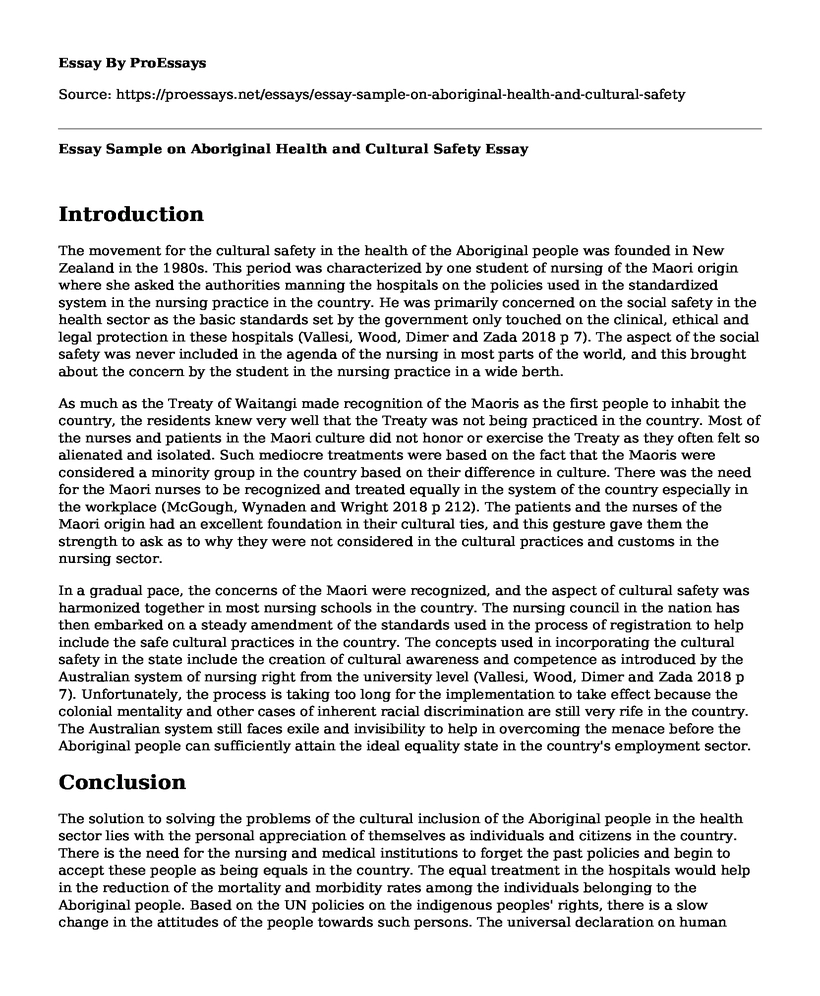Introduction
The movement for the cultural safety in the health of the Aboriginal people was founded in New Zealand in the 1980s. This period was characterized by one student of nursing of the Maori origin where she asked the authorities manning the hospitals on the policies used in the standardized system in the nursing practice in the country. He was primarily concerned on the social safety in the health sector as the basic standards set by the government only touched on the clinical, ethical and legal protection in these hospitals (Vallesi, Wood, Dimer and Zada 2018 p 7). The aspect of the social safety was never included in the agenda of the nursing in most parts of the world, and this brought about the concern by the student in the nursing practice in a wide berth.
As much as the Treaty of Waitangi made recognition of the Maoris as the first people to inhabit the country, the residents knew very well that the Treaty was not being practiced in the country. Most of the nurses and patients in the Maori culture did not honor or exercise the Treaty as they often felt so alienated and isolated. Such mediocre treatments were based on the fact that the Maoris were considered a minority group in the country based on their difference in culture. There was the need for the Maori nurses to be recognized and treated equally in the system of the country especially in the workplace (McGough, Wynaden and Wright 2018 p 212). The patients and the nurses of the Maori origin had an excellent foundation in their cultural ties, and this gesture gave them the strength to ask as to why they were not considered in the cultural practices and customs in the nursing sector.
In a gradual pace, the concerns of the Maori were recognized, and the aspect of cultural safety was harmonized together in most nursing schools in the country. The nursing council in the nation has then embarked on a steady amendment of the standards used in the process of registration to help include the safe cultural practices in the country. The concepts used in incorporating the cultural safety in the state include the creation of cultural awareness and competence as introduced by the Australian system of nursing right from the university level (Vallesi, Wood, Dimer and Zada 2018 p 7). Unfortunately, the process is taking too long for the implementation to take effect because the colonial mentality and other cases of inherent racial discrimination are still very rife in the country. The Australian system still faces exile and invisibility to help in overcoming the menace before the Aboriginal people can sufficiently attain the ideal equality state in the country's employment sector.
Conclusion
The solution to solving the problems of the cultural inclusion of the Aboriginal people in the health sector lies with the personal appreciation of themselves as individuals and citizens in the country. There is the need for the nursing and medical institutions to forget the past policies and begin to accept these people as being equals in the country. The equal treatment in the hospitals would help in the reduction of the mortality and morbidity rates among the individuals belonging to the Aboriginal people. Based on the UN policies on the indigenous peoples' rights, there is a slow change in the attitudes of the people towards such persons. The universal declaration on human rights that was adopted in the year 1948 spelled out the plight and manner of treating the indigenous people globally (McGough, Wynaden and Wright 2018 p 210). There was a universal condition for all the countries to offer citizenship to these people and the Australian government was no exception. Unfortunately, the Aboriginal people in Australia had no idea on this declaration, and this was only realized after twenty years in the country. The 1967 referendum was a landmark in the history of the country when the Aboriginals were made citizens in the country.
List of References
McGough, S., Wynaden, D. and Wright, M., 2018. Experience of providing cultural safety in mental health to Aboriginal patients: A grounded theory study. International journal of mental health nursing, 27(1), pp.204-213.
Vallesi, S., Wood, L., Dimer, L. and Zada, M., 2018. "In Their Voice"-Incorporating Underlying Social Determinants into Aboriginal Health Promotion Programs. International journal of environmental research and public health, 15(7).
Cite this page
Essay Sample on Aboriginal Health and Cultural Safety. (2022, Jul 29). Retrieved from https://proessays.net/essays/essay-sample-on-aboriginal-health-and-cultural-safety
If you are the original author of this essay and no longer wish to have it published on the ProEssays website, please click below to request its removal:
- Tools to Help Nurses Gain Critical Thinking Skills Essay
- Essay Sample on Nutritional Risks the Client (Pregnant Mother)
- The Rohingya Community Essay Example
- Essay Example on Telehealth Revolution: Better Care Through Data Systems
- Essay Sample on Stress-Related Problems: High Prevalence in Health Care Facility Visits
- Essay Example on Non-Acute Healthcare: Cardiorespiratory Conditions & Long-Term Care
- Women's Fight for Equal Rights: A Historical Struggle - Essay Sample







